Chapter: 12th Physics : Electrostatics
Applications of Gauss law
Applications of Gauss law
Electric field due to
any arbitrary charge configuration can be calculated using Coulomb’s law or
Gauss law. If the charge configuration possesses some kind of symmetry, then
Gauss law is a very efficient way to calculate the electric field. It is
illustrated in the following cases.
(i) Electric field due to an infinitely long charged wire
Consider an infinitely
long straight wire having uniform linear charge density λ. Let P be a point
located at a perpendicular distance r from the wire (Figure 1.38(a)).

The electric field at
the point P can be found using Gauss law. We choose two small charge elements A1
and A2 on the wire which are at equal distances from the point P.
The resultant electric field due to these two charge elements points radially
away from the charged wire and the magnitude of electric field is same at all
points on the circle of radius r. This is shown in the Figure 1.38(b). From
this property, we can infer that the charged wire possesses a cylindrical
symmetry.
Let us choose a
cylindrical Gaussian surface of radius r and length L as shown in the Figure
1.39.
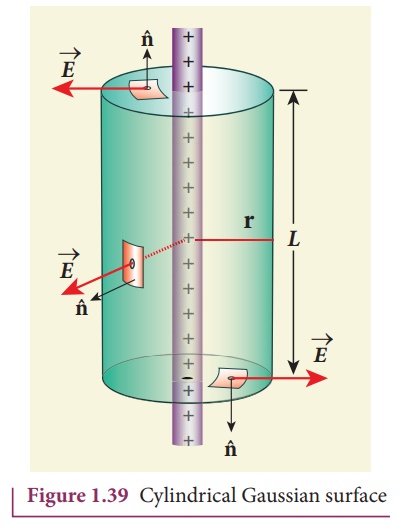
The total electric flux
in this closed surface is calculated as follows.
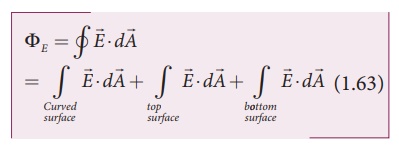
It is seen from Figure
(1.39) that for the curved surface, ![]() is parallel to
is parallel to ![]() and
and ![]() ⋅ d
⋅ d ![]() = EdA. For the top and bottom surfaces,
= EdA. For the top and bottom surfaces, ![]() is
perpendicular to
is
perpendicular to ![]() and
and ![]() ⋅ d
⋅ d ![]() = 0
= 0
Substituting these
values in the equation (1.63) and applying Gauss law to the cylindrical
surface, we have

Since the magnitude of the electric field for the entire curved surface is constant, E is taken out of the integration and Qencl is given by Qencl = λL .

Here  = total area of the curved surface = 2πrL. Substituting this in equation (1.65), we get
= total area of the curved surface = 2πrL. Substituting this in equation (1.65), we get

The electric field due
to the infinite charged wire depends on 1/r rather than 1/r2
for a point charge.
Equation (1.67)
indicates that the electric field is always along the perpendicular direction (
r^ ) to wire. In fact, if λ > 0 then ![]() points
perpendicular outward from the wire and if λ < 0, then
points
perpendicular outward from the wire and if λ < 0, then ![]() points perpendicular inward (-r^).
points perpendicular inward (-r^).
The equation (1.67) is
true only for an infinitely long charged wire. For a charged wire of finite
length, the electric field need not be radial at all points. However, equation
(1.67) for such a wire is taken approximately true around the mid-point of the
wire and far away from the both ends of the wire
(ii) Electric field due to charged infinite plane sheet
Consider an infinite
plane sheet of charges with uniform surface charge density σ. Let P be a point
at a distance of r from the sheet as shown in the Figure 1.40.
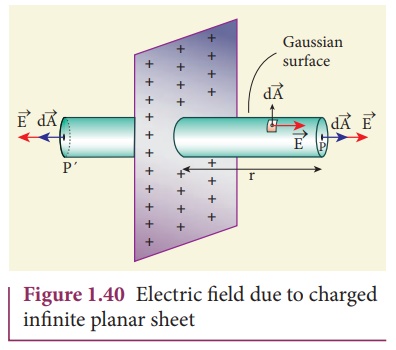
Since the plane is
infinitely large, the electric field should be same at all points equidistant
from the plane and radially directed at all points. A cylindrical shaped
Gaussian surface of length 2r and area A of the flat surfaces is chosen such
that the infinite plane sheet passes perpendicularly through the middle part of
the Gaussian surface.
Applying Gauss law for
this cylindrical surface,
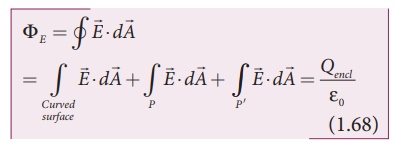
The electric field is
perpendicular to the area element at all points on the curved surface and is
parallel to the surface areas at P and P′ (Figure 1.40). Then,

Since the magnitude of
the electric field at these two equal surfaces is uniform, E is taken out of
the integration and Qencl is given by Qencl
= σA , we get
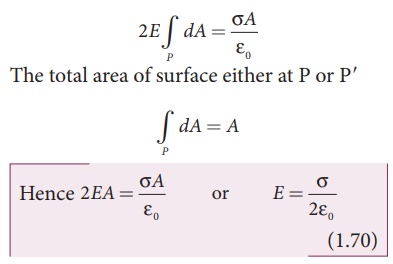

Here n^ is the outward unit vector normal to the
plane. Note that the electric field due to an infinite plane sheet of charge
depends on the surface charge density and is independent of the distance r.
The electric field will
be the same at any point farther away from the charged plane. Equation (1.71)
implies that if σ > 0 the electric field at any point P is outward
perpendicular n to the plane and if σ < 0 the electric field points
inward perpendicularly (-n ) to the plane.
For a finite charged
plane sheet, equation (1.71) is approximately true only in the middle region of
the plane and at points far away from both ends.
(iii) Electric field due to two parallel charged infinite sheets
Consider two infinitely
large charged plane sheets with equal and opposite charge densities +σ and -σ
which are placed parallel to each other as shown in the Figure 1.41.

The electric field
between the plates and outside the plates is found using Gauss law. The
magnitude of the electric field due to
an infinite charged
plane sheet is σ/2ε and it points
perpendicularly outward if σ > 0 and points inward if σ < 0.
At the points P2
and P3, the electric field due to both plates are equal in magnitude
and opposite in direction (Figure 1.41). As a result, electric field at a point
outside the plates is zero. But inside the plate, electric fields are in same
direction i.e., towards the right, the total electric field at a point P1

The direction of the
electric field inside the plates is directed from positively charged plate to
negatively charged plate and is uniform everywhere inside the plate.
(iv) Electric field due to a uniformly charged spherical shell
![]() Consider a
uniformly charged spherical shell of radius R and total charge Q as shown in
Figure 1.42. The electric field at points outside and inside the sphere is
found using Gauss law.
Consider a
uniformly charged spherical shell of radius R and total charge Q as shown in
Figure 1.42. The electric field at points outside and inside the sphere is
found using Gauss law.
Case (a) At a point
outside the shell (r > R) Let us choose a point P outside the shell at a
distance r from the center as shown in Figure 1.42 (a). The charge is uniformly
distributed on the surface of the sphere (spherical symmetry). Hence the
electric field must point radially outward if Q > 0 and point radially
inward if Q < 0. So we choose a spherical Gaussian surface of radius r is
chosen and the total charge enclosed by this Gaussian surface is Q. Applying
Gauss law

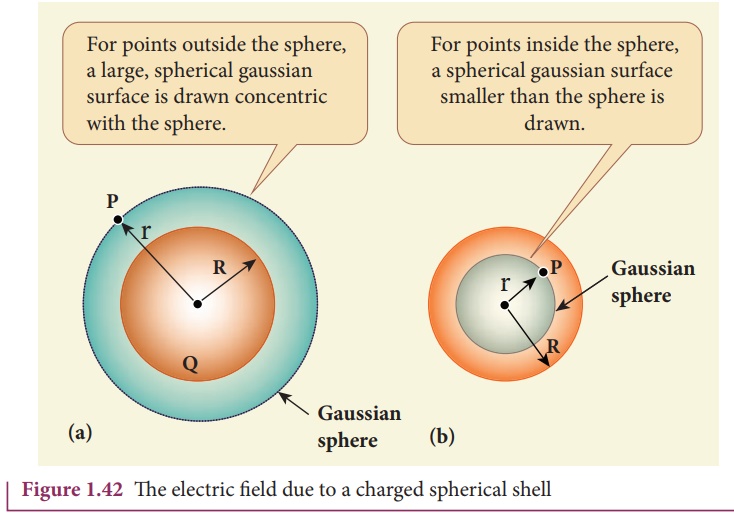
The electric field ![]() and d
and d ![]() point in the same direction (outward normal) at all the
points on the Gaussian surface. The magnitude of
point in the same direction (outward normal) at all the
points on the Gaussian surface. The magnitude of ![]() is also
the same at all points due to the spherical symmetry of the charge distribution.
is also
the same at all points due to the spherical symmetry of the charge distribution.
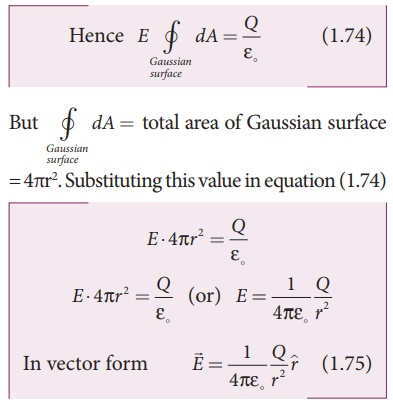
The electric field is
radially outward if Q > 0 and radially inward if Q < 0. From equation
(1.75), we infer that the electric field at a point outside the shell will be
same as if the entire charge Q is concentrated at the center of the spherical
shell. (A similar result is observed in gravitation, for gravitational force
due to a spherical shell with mass M)
Case (b): At a point on
the surface of the spherical shell (r = R)
The electrical field at
points on the spherical shell (r = R) is given by

Case (c) At a point
inside the spherical shell (r < R)
Consider a point P
inside the shell at a distance r from the center. A Gaussian sphere of radius r
is constructed as shown in the Figure 1.42 (b). Applying Gauss law
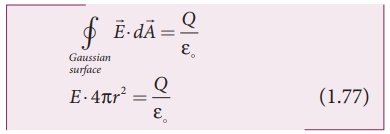
Since Gaussian surface
encloses no charge, So Q = 0. The equation (1.77) becomes

The electric field due
to the uniformly charged spherical shell is zero at all points inside the
shell.
A graph is plotted
between the electric field and radial distance. This is shown in Figure 1.43.
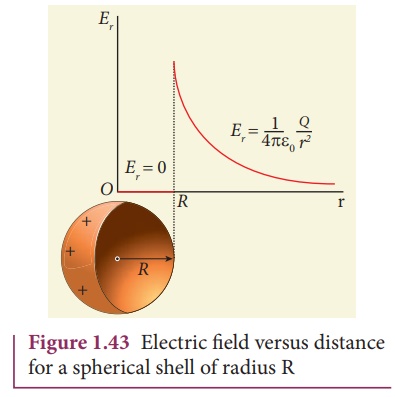
Related Topics